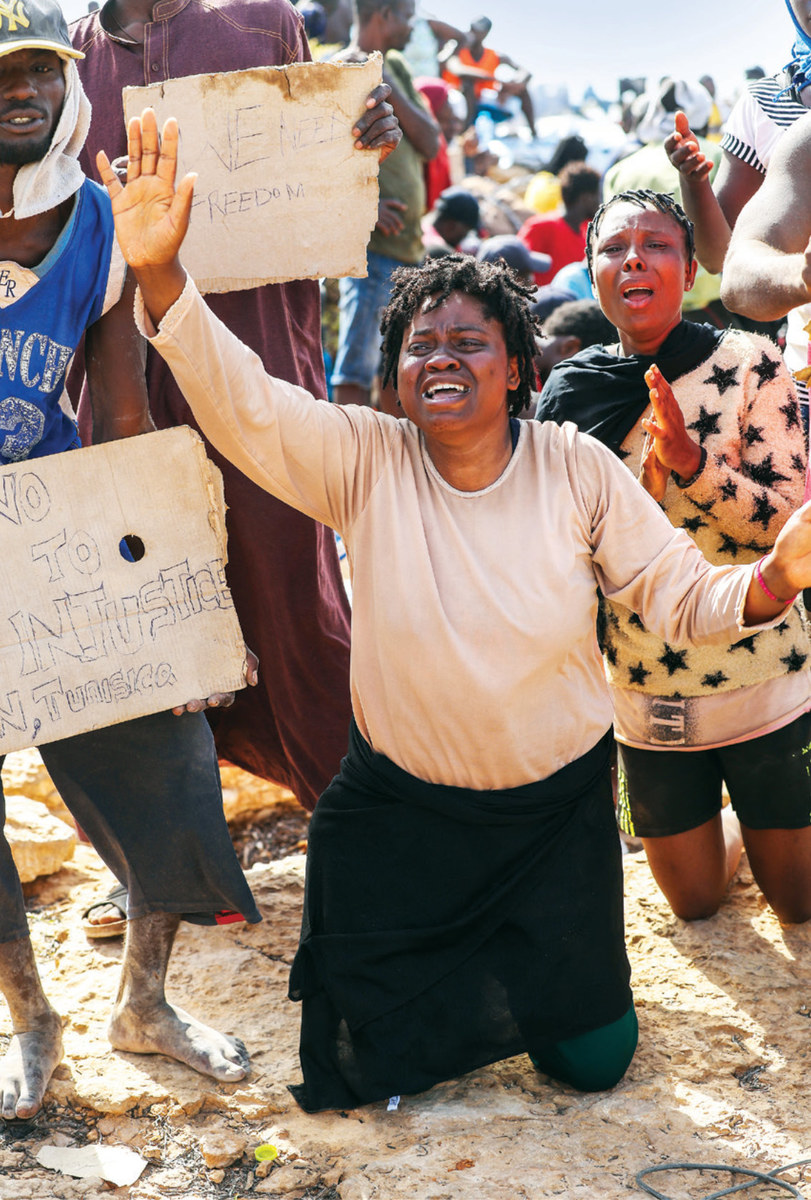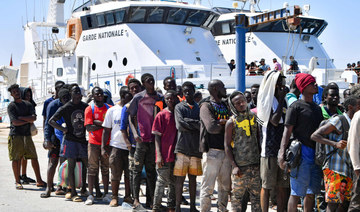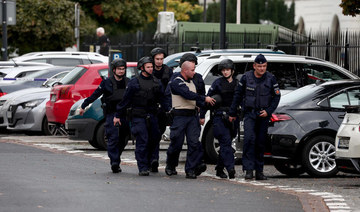DUBAI: Youssef Bayrakdar was 19 when he and his family were forced to leave their home in Homs in March 2012, just a year after the conflict in Syria began. His sister, along with her husband, their children and every resident of their building, had been killed by militiamen.
After five days, grieving families were finally permitted to bring out their dead for burial. “The militias continued killing and totally eliminated nearly 25 neighborhoods and massacred 100 families,” Bayrakdar told Arab News.
He and his surviving family fled to the countryside, where they remained until 2015. However, the war followed them, with rockets landing near their home. While his parents chose to return to the city, Bayrakdar and his two siblings became politically active.

Migrants from Africa, stranded on the seashore at the Libyan-Tunisian border in Ras Jedir, plead to be saved from a desert zone between Libya and Tunisia on July 26, 2023. (AFP)
“Today, the three of us are living in the northern part of Aleppo (which is not under government control) and we can’t visit our parents,” he said. “I strongly believe that we will never ever see them again.”
Bayrakdar is just one among millions of people around the globe who have been displaced by conflict, persecution, natural disaster or a lack of economic opportunity.
According to the UN refugee agency, UNHCR, 13 million people from Syria have fled their areas of origin or habitual residence to seek refuge in other parts of the country or in neighboring or other nations since the start of the crisis there in 2011.
Some 5.6 million Syrians have sought refuge overseas, while 6.9 million people remain internally displaced. Although some Syrian refugees have since returned home, the exact numbers have been difficult for aid agencies to quantify.

Although Syria remains the biggest source of displaced people, it is closely followed by Ukraine, Afghanistan, Venezuela, South Sudan, and Myanmar.
“Some 52 percent of all refugees and others in need of international protection came from just three countries: Syria (6.5 million), Ukraine (5.7 million) and Afghanistan (5.7 million),” Matthew Saltmarsh, head of news and media at UNHCR, told Arab News.
“But of course, there are many other countries producing large numbers of refugees: Sudan, South Sudan, Venezuela and Myanmar to name a few.”
Indeed, the ongoing violence in Sudan, which began on April 15, has forced about 4.3 million people to flee their homes. More than 3.2 million are internally displaced, 900,000 have fled to neighboring countries, and 195,000 South Sudanese citizens have been forced to return home, according to the International Committee of the Red Cross.

The resulting humanitarian crisis risks destabilizing the wider region, as many of the countries bordering Sudan have themselves endured decades of conflict, political and economic instability, hunger and drought, and are in need of international support.
“It is important to flag that Sudan was already experiencing a heavy internal displacement and refugee crisis even before the start of the current conflict, as it was already hosting more than 1 million refugees displaced because of conflicts in neighboring countries,” Imene Trabelsi, the ICRC’s regional spokesperson, told Arab News.
According to UN figures, almost 110 million people worldwide are currently classified as displaced — double the number just a decade ago.

Multiple ongoing conflicts, including the war in Ukraine, coupled with climate-driven upheaval, mean more people than ever have been uprooted from their homes, and often forced to brave dangerous routes to find relative safety, said Saltmarsh.
“Sometimes it seems that humans have become better at fighting than making peace,” he added. “Either the international community comes together to act to address this human tragedy, resolve conflicts and find lasting solutions, or this terrible trend will continue.
“We need urgent, immediate, collective action to address the root causes and impact of displacement.”
IN NUMBERS
108.4 million People worldwide who have been forcibly displaced.
76% Refugees hosted by low- and middle-income countries.
40% Proportion of all forcibly displaced people that are children.
(Source: UNHCR)
There are some notable exceptions to this gloomy picture, of countries and communities that are working together to find solutions so that refugees can be resettled and provided with opportunities for them to build sustainable livelihoods, or helped to voluntarily return to their places of origin.
However, humanitarian aid agencies believe governments are simply not doing enough to promote peace through diplomacy, allowing conflicts and mass displacements to grind on unabated.
“The international community can do a lot to prevent wars and to stop them,” Karl Schembri, a media advisor for East Africa and Yemen at the Norwegian Refugee Council, told Arab News.
“There are many tools in the diplomats’ toolbox that can be used, in different contexts, to put pressure on warring parties and hold them to account. The fact that there are so many wars going on is less of an indication of what can be done, and more about the levels of political willingness to engage.
“Especially the wealthier countries, which are themselves engaged in wars, can provide all the funding necessary to assist the displaced and victims of these man-made disasters.”

South Asian migrants rescued by Tunisia’s national guard during an attempted crossing of the Mediterranean rest at the port of El-Ketef in Ben Guerdane in southern Tunisia on June 24, 2021. (AFP file photo)
Schembri said his organization, the NRC, and other humanitarian agencies work wherever the security situation allows them to operate to provide a range of assistance, from financial and legal aid to shelter, food, water and education.
Other humanitarian agencies help displaced people reconnect with their families after becoming separated. Since July, for example, the ICRC has reunited 558 Sudanese refugees, who fled to Chad, with their relatives back home.
However, with donors being asked to respond to so many simultaneous crises around the globe, dwindling funding is increasingly a challenge to humanitarian efforts. Until solutions can be found, aid agency officials said governments must provide refugees with safe and legal passage.
“Wealthier countries can put safety and solidarity at the heart of their policies,” said Saltmarsh. “If you look at the Mediterranean — which is in the news right now — collective efforts, including greater coordination between all Mediterranean states, solidarity and responsibility-sharing are essential to save lives.

A rescuer of the German NGO Sea-Watch helps a migrant to board a boat during an operation to rescue victims of a shipwreck in the Mediterranean Sea on Nov., 2017. (AFP file photo)
“This includes the establishment of an agreed regional disembarkation and redistribution mechanism for people who arrive by sea, which we continue to advocate for. The duty to rescue people in distress at sea without delay is a fundamental rule of international maritime law.
“It is also important to create more safe pathways for people forced to flee conflict and persecution, while cracking down on smugglers and those who take advantage of the chaos of the human movements. The final part is creating conditions in home countries that dissuade people from resorting to perilous journeys to seek safety.”
According to the International Organization for Migration’s Missing Migrants Project, 1,166 people died or went missing while attempting to cross the Mediterranean Sea to Europe between the start of this year and June 9.

Infographic courtesy of [email protected]
“Policies have failed to treat the root causes of migration, like poverty and lack of jobs,” Ahmed Bayram, regional media and communication adviser for the NRC in Amman, told Arab News.
“No one wants to leave their home, and the international community needs to think seriously about what is forcing people to take such decisions.
“I would say the international community has not done all it can to stop wars from taking years to end. The political dynamics have played out across conflict zones in a way that further fueled the wars.

Youssef Bayrakdar. (Supplied)
“As a humanitarian aid agency, we look at what has been done to help those affected. The number of refugees is the highest it has been. The ripple effect of war and climate change is sweeping across affected communities — disasters, drought conditions, poverty and lack of jobs and education opportunities. The impact will be felt for generations to come.”
For Bayrakdar, who has spent his entire adult life as a displaced person, only concerted action by the international community to resolve the 12-year civil war in Syria will allow families to reunite and communities to heal.
“We always think of assisting the displaced, and not talking about stopping the displacement, or looking into the reasons why it happened,” he told Arab News.
“Stopping the displacement can be through eliminating its reasons. (However), politicians (among the international community) don’t feel the pain we are feeling. They haven’t lost their loved ones like we did.”

Caption





























